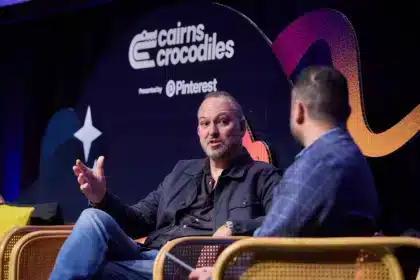While attending Adobe’s Summit conference in Las Vegas in late March, B&T sat down with TVNZ’s Robert Hutchinson, GM digital – commercial, to explore what the future of connected TV looks like across the ditch.
Robert Hutchinson laughs at my opening jab about Australian-New Zealand relationships and tells me not only is his wife Australian, but that he worked for the ABC here for the best part of 13 years.
Now working for TVNZ he tells me it took some adjusting to work for the equivalent to the ABC only that it’s covered in ads. Te Reo Tātaki (TVNZ) translates to ‘the leading voice’. TVNZ is New Zealand’s state-owned, commercially funded broadcaster. TVNZ’s purpose is to inspire the conversations of Aotearoa, and enrich the lives of New Zealanders by sharing the moments that matter to its communities, regions and people.
Each day, TVNZ reaches more than 2 million Kiwis through channels TVNZ 1, 2, DUKE and online entertainment platform, TVNZ+. Leading news site 1news.co.nz and socially driven online news brand Re: connect people to the important issues throughout the day, however they choose to engage.
“It’s been the number one and number two linear television stations forever, and launched its digital offering over ten years ago,” he explains.
TVNZ’s digital offering has grown so emphatically that it’s now the third-largest streaming platform in the in the country.
“So only Netflix and YouTube are bigger. And in in fact, there’s a group – Netflix YouTube and TVNZ+ – then there’s a big drop down to the long tail which is you know Disney+, Prime and Warner Brothers Discovery and those sorts of things.”
What’s really different about TVNZ’s offering, however, is that all the content that’s normally behind a paywall in Australia is for free in New Zealand and ad supported.
“The content you would see on Paramount+, the content that’s on Peacock and the US is all on our platform, the ITV catalogue.
Why is it all for free? “Because we’re really good at selling ads, and we’ve never run a subscription business in our lives,” Hutchinson tells me in his matter-of-fact manner.
“That’s turned out to be an amazing way to build a very, very large audience. I mean, if you mention our position, you’d almost have to put seven, nine and ten on top of each other to end up in the same share of market.”
Apples and Oranges
Television audiences are measured in the whole household, while the digital audiences are counted by the individual profile.
New Zealand has a Total Audience Measurement (TAM) provided by Nielsen, which measures only linear TV.
“We do have streaming meters now in New Zealand, and at some point that data will contribute to our journey to build a co-viewing model of our audience, but I don’t want put it a time frame on it. I mean, I know that VOZ took five years, right?
“So we’re probably gonna take a much more pragmatic approach New Zealand about how to get to a whole audience number for VOD. What I would say is the early data we’ve seen shows that we have quite high co-viewing ratios, particularly on connected TV, which you would expect. Not that far from what linear TV would achieve as well.
“So you can’t measure them against each other. What I would say is we continue to see double digit audience growth on TVNZ+ and linear television continues to have audience decline. I love when I see months where TVNZ+ grew as much as linear declined, doesn’t have any every month, unfortunately. But the fact that we do occasionally see that is a really pivotal fact. I’ve observed it mostly when we have a super premium product that is TVNZ+ exclusive.”
Revenue-wise, around quarter of TVNZ’s ad revenue is digital. So the rump is still on linear. But again, linear, revenues are in decline, and digital revenues are still growing.
“Even in this very tough market, which I assume Australia’s had, we’re still been able to grow our digital revenue, even when digital as a category is going been backwards. Materially backwards. So we, we feel the offering is lifting its weight in terms of growth potential. When the market comes round, because, ad markets always fix themselves, we feel really well positioned to take advantage of that,” Hutchinson says.
So why on earth did this ANZ meeting take place in Las Vegas? The answer is that a year ago, TVNZ implemented Adobe’s Real Time Customer Data Platform.
“We’ve always been a first party data shop because everyone’s logged in; you can’t watch anything on our digital platform without being logged in.”
TVNZ started off very simply by offering TV demos on digital. “You can buy all people 25-54, but you are buying them on digital. And that was great. And it’s actually going to continue to be a very large part of our business, because brands are now using our video on demand (VOD) offering as it as an extension of their linear buy to deliver incrementality.”
But advertisers were asking for more efficiencies. The small end of town wanted to know that they were really talking to people who are most like our customers. The big end of town wanted richer and deeper insights into what’s going on.
Segmentation
Every single play event is linked to every single piece of meta data attached to that program, and every single bit of technical delivery data attached to that play event gets sucked up and put into each individual profile.
So TVNZ+ is able to do simple things, like people who love sport, or people who love renovation shows. It’s able to build segments of people who have a passion for certain types of content, but it’s also able to build segments of people who have certain behaviours.
“A client asks us to build a segment of only people who predominantly watch TVNZ+ using mobile data. They only want to talk to them, not to people using Wi-Fi. And that all can flow out of our performance management stack as integrated into the CDP, just like our playout stack is integrated into our CDP, we’re able to blend all that data So that was step one, and that’s we took to market.”
Step two, which came only a few weeks later, was the ability for advertisers to match their customer base with TVNZ’s audience base in a privacy-compliant and secure way: first-party data, to first-party data.
This can be either Adobe to Adobe, or for customers who don’t have Adobe, TVNZ is able to do it using AWS Clean Rooms. Every advertiser who has a marketing list with permissions attached can enter into an audience match.
“Why that’s super powerful is, if you’re a marketer, you can do a match with us, and then they will give you a dashboard of your customers in television for the first time ever. You can actually see what they watch, how they index versus our standard audience. You can see the household because the match gives you not just the master profile that was matched, but we have built a household graph inside the CDP that enables us to have the other profiles.
“Oh look there’s four profiles. One of them is a kid’s profile. Now, we don’t target ads at kids, but we can target ads at parents. We’re able to build a really rich understanding, and then give the marketer that understanding.
“Why that’s important is television is the top of the funnel, and every other analytics tool anyone’s talking about is all the way down here, at the bottom of the funnel. They are just looking at last click attribution. How do I optimize that?
“But in the place where intent is formed, in the emotional space, we’re able to give marketers an insight into that. So it’s a big change,” explains Hutchinson.
With the GenStudio product that Adobe announced at Summit, advertisers would be able to dynamically alter advertising based on feedback from what’s happening at the top of the funnel.
“It’s a way of understanding where the journey to even know your brand exists and build an emotional relationship happens.”
Invisible insights revealed
So TVNZ took that solution to market, and that enabled advertisers to do exclusion or remarketing or retargeting, all those capabilities. That’s all driven by the CDP.
Then it was able to use the CDP to push data out again into its data warehouse, where it’s started to build data models that are able to do predictions. The one that’s most used by advertisers right now is a similar audiences model.
Let’s say a brand with only a small permissioned marketing list does a match with TVNZ and it ends up with 2500 matches, they can push that into the data model and the data model will rank TVNZ’s 2.5 million profiles by most to least similar.
That advertiser can then say I’ll buy the most similar 100,000.
And so suddenly even small advertisers can do television scale campaigns against the audience members who look most like their customer base.
Hutchinson says that’s a product TVNZ took out to market a few months ago, and that is really taking off.
Then the most recent product is TVNZ’s first second-party data partnership.
“We’ve partnered with a New Zealand specialist data broker. Now we can offer segments like in the market for a mortgage or, decision maker inside a medium business in this business category, or tradies, or homeowner versus renter and things like that.
“Those segments are very appealing to our smaller advertisers who want efficiency: I just need to talk to people who are looking for personal loans.”
And are you able to then inform your linear audience based off this because you’ve got the household?
“It’s really fascinating. What we saw was because the audience insight is across both video on demand and simulcast, you can use simulcast as a proxy for linear. You can see one-to-one consumption of linear television basically.”
Hutchinson explains this advantage with a real CMO’s insight. The CMO was able to see his/her television media plan was excellent; they were really hitting who they wanted to hit. However, this one brand they have, which is actually their challenger brand, its consumers watch completely different programming from all of its other customers.
That CMO was able to change its planning to address those customers in a different way.
“That’s an insight that’s kind of invisible. So for the first time, they’re able to say, our challenger brand, the customers you own it, have a completely different linear media consumption from our core brands.”








